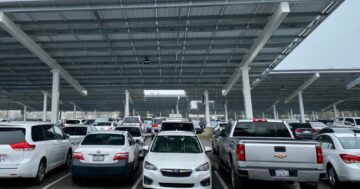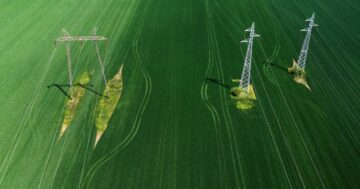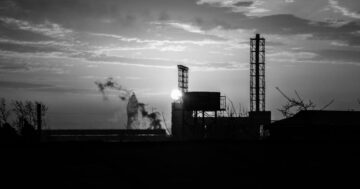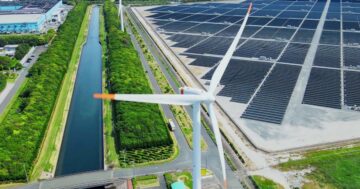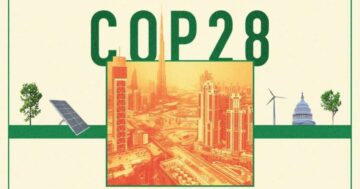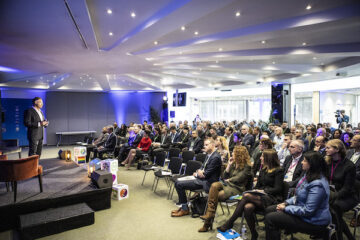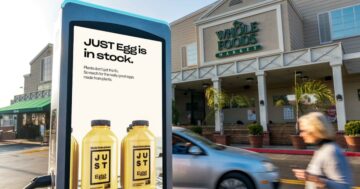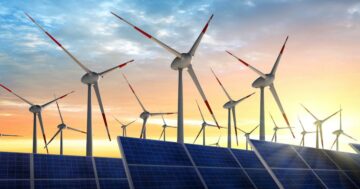
This article originally appeared in our Circularity Weekly newsletter. Subscribe here.
Over the past several years, the condemnatory buzz that surrounds PFAS has grown louder. Known formally as perfluoroalkyl or polyfluoroalkyl compounds and informally as “forever chemicals,” the roughly 5,000 human-made compounds that fall under the PFAS umbrella are highly persistent, linked to a variety of adverse health effects and alarmingly present in drinking water, food and even blood and breast milk across the nation.
And it’s no wonder they’re seemingly everywhere. Thanks to their unique repellent properties, PFAS are used widely in a variety of goods — everything from beauty products to apparel to food packaging and beyond. Just last week, a new study by Toxic-Free Future revealed nearly 75 percent of products labeled as water- or stain-resistant contain forever chemicals, a finding that tarnished retailers from Walmart to REI.
Increased scrutiny has led to some promising developments: The EPA has recently established a strategic roadmap to study and address PFAS and a patchwork of state regulations are tackling forever chemicals in things such as drinking water and packaging. Meanwhile, in the private sector, a wide variety of corporations have committed to phasing out PFAS use in the coming years. But some organizations are ahead of the curve.
That’s why I sat down with Jesper Danielsson, head of design and product at Houdini Sportswear, a small outdoor apparel company based in Stockholm, Sweden. Leveraging Atmos — a hydrophilic membrane made with recyclable polyester — and a biomimicry-inspired, water repellency treatment by Organotex, Houdini’s water-repellent outdoor products have been PFAS-free since 2018.
But that’s not where their circular credentials stop. From material selection — 100 percent of their fabrics are recycled, recyclable, renewable, biodegradable or Bluesign certified — to the implementation of rental, subscription, resale and repair business models to the circular design principles that guide their ethos — Houdini is going full steam ahead towards a fully circular system. In fact, their goal is to have all products and services be circular by design this year, and for the entire Houdini ecosystem — across its value chain and user phases — to be designed for circularity by 2030.
If we take a step back and look at nature as the blueprint, the goal is a system where one piece feeds another, feeds another into a bigger circle: a systemic approach.
Here’s my interview with Danielsson, exploring the numerous facets of Houdini’s circular aspirations. It has been edited for length and clarity.
Suz Okie: PFAS are obviously top of mind, but Houdini has been PFAS-free since 2018. Tell me a bit about the motivations that led to this strategy, and what it took to achieve it.
Jesper Danielsson: Phasing out PFAS was one step in our journey towards creating a circular system. It’s really a question of keeping our products and resources clean so they can go from one use to the next.
We started the process back in 2012 and it’s been a long, long journey. From the chemistry to looking at how different materials bind together — there was a lot of trial and error. As a small company, we needed to set a clear direction of what the win-wins were. We wanted to lead by example and work with our suppliers to push forward in that direction.
Okie: What were the biggest obstacles when it came to this transition?
Danielsson: Performance and education. The first massive hurdle was to uphold the performance aspect of what we do. When it comes to water repellency we feel that we can deliver a similar if not better performance, but when you start looking at oil repellency — it’s not quite in the same ballpark.
So that’s the educational part. We need to help our end users understand how to maintain and care for their garments. And by doing that, we can then deliver an experience that is on the same level or higher to what they were getting before. I think it’s important for us to really deliver on both aspects. To not become a brand that is clinging on to old standards, but one that showcases that technology in nature can work in symbiosis with our products and the system they’re within — if we can accomplish that, we can get more people to jump onto this journey with us.
Okie: Zooming out just a bit, I’d love to talk about your design process. What does that look like in practice?
Danielsson: Well, before we even put pen to paper, we go through our designer checklist. It’s about eight questions, starting with, “Does this product deserve existence?” Has someone else already created the perfect recipe, and if so should we just point our customers to that other brand so we can put our resources elsewhere?
We also ask, will it last long enough? Is it versatile enough? Will it age with beauty? Will it be easy enough to repair? All the way down to is it durable enough for our rental program? And does it have a next life solution?
When a new designer on the team faces that last question, it really shifts their focus on why we’re doing what we’re doing.
Okie: Can you share a bit about how this design checklist was created and the thought process that went into establishing it?
Danielsson: We see our checklist as a pragmatic tool that was born from our four guiding principles.
First, less is more. Reduction, at its finest, creates versatility. And if we manage to create truly versatile products, we need to own less products. We can have smaller wardrobes and a lot less impact in general. But less is more is also applicable to what goes into the product. Products that are less complex — don’t contain PFAS, for example — are more pure and easier to recycle.
“Less is more” also allows us to make garments that last for a longer period of time, which leads us to our second principle: Built to last. That applies to both quality and to creating garments that work again and again and again. The durability of our products is something that we’re very proud of: Not too long ago we performed a survey where we found end users wore our garments 1,287 times in the product’s lifespan, compared to an industry standard of seven to 10 times. At first we went back to that number again and again and again, because we thought it didn’t make sense. But we also know that some outdoor guides have been using these products for 10-plus years, and they’re still super excited with them. That durability is crucial to our philosophy.
The other part of “built to last” really comes down to style. If you want to have something which lasts for such a long period of time, it has to be designed to age well, to look contemporary now but also in 10 years time. It’s never been about creating the latest “new,” but about creating something that never gets old.
The third principle is about holistic comfort. As an outdoor brand, that starts with the creation of microclimate products that work really well, but expands to embrace individuality in mind, body and soul. We strive for products that evoke confidence, that you can feel good about having and wearing — which includes making sure that the people who produced it have a high standard of living and quality of life.
The last principle is, of course, making it circular — starting at the product level going all the way up to the business models.
Okie: Speaking of your business models — from repair to resale to rental and subscription, you’re pursuing a lot of strategies at once. Can you share a bit about your motivation for pursuing all these models simultaneously, rather than picking a lane?
Danielsson: If we take a step back and look at nature as the blueprint, the goal is a system where one piece feeds another, feeds another into a bigger circle: a systemic approach.
So we start with creating really exceptional, durable products. That durability lends itself to a rental service where our end users become caretakers in our system. But at a certain point those rental products don’t feel as crisp, so they’re ready for resale. These two services naturally fit together in that way. Financially, it’s also important to us to deliver accessible, uncompromised products at different price points. So resale becomes an important part of that ethos as well.
Our repair service also naturally fits into this system, prolonging the product’s lifespan so it can be rented longer or still be resold. We offer a lifetime warranty — a guarantee that each product and all its components should hold up during the lifetime of the product. If it doesn’t, we repair it for you. So that’s a lot of pressure down to the design team to create garments that are in balance and symbiosis — to make sure this fits together with that.
The next level taps into the recyclability — as we go through all of these cycles, we want to have kept them pure enough to be recycled. Quite often we can repair something and bring it back to life a first, second or third time. But then in the end, we have a sorting system in the warehouse to separate out the synthetic and natural materials that return value to the system.
Before we even put pen to paper, we go through our designer checklist. It’s about 8 questions, starting with, ‘Does this product deserve existence?’
Okie: How do your connected goods fit into this multi-pronged strategy?
Danielsson: We’ve always tried to build communities. Communities where people can reconnect to nature, but also understand what we as an organization are doing. We see this as a necessity to make the circular economy work at scale. At any point in time, an end user can throw one of our garments away. We have no control over that, so we need to build engagement for end users. We need to move from a transactional economy, where our products are purchased and the relationship ends to one where the dialogue continues.
A connected good is a gateway. A door that allows for two-way communication. We can use that door to educate people on how to care for the garments and how to get the most out of them. But it can also enable other parts of our system. It can enable our customers to raise their hand when they’re ready to resell their garment, or when something has gone astray and needs a repair.
It’s really helpful in linking our system together, but also in creating that emotional durability. Through dialogue, we can create a connection between you and your garments.
Okie: Finally, how do you think about your impact as a brand?
Danielsson: To try and make it pragmatic, we quantify our impact through a formula, which reads out P x V + L = I.
P is our production, or our product — making our product and our production as lean as possible and bringing down the energy usage. This is where a lot of companies start. But for us, this meant making everything 100 percent recycled, recyclable, renewable, biodegradable or bluesign certified without compromising durability or performance.
V is volume, which means creating fewer, smarter products. If you can go from your bouldering gym to meet up with your in-laws and then finish off having a beer with your friends with the same jacket, we’ve brought down the amount of products you need. Our garments become wearable multitools.
Through that, these multitools can enable and encourage another way of living, which leads us to L: lifestyle. If we as a brand can enable adventures, that reconnection to nature that creates memories you want to cling on to — that’s what leads to the biggest impact.


